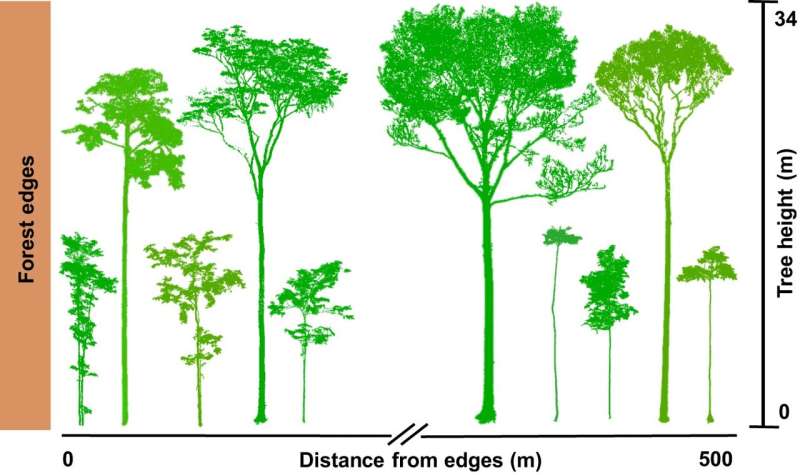This article has been reviewed according to Science X's editorial process and policies. Editors have highlighted the following attributes while ensuring the content's credibility:
fact-checked
peer-reviewed publication
trusted source
proofread
Forest fragmentation is changing the shape of Amazonian trees, finds study

Due to clear-cutting, the area of undisturbed rainforests is decreasing. At the edges of deforested areas, temperatures rise, and there is more light. Trees are able to adapt to changes in their living conditions and environment, but how does environmental change affect the shape of trees in the tropical rainforest? To date there has been no overall understanding of this.
Associate Professor Eduardo Maeda from the University of Helsinki coordinated an international project investigating tree shapes on the edges of the tropical rainforest. Matheus Nunes, who previously worked at the University of Helsinki and is now active at the University of Maryland, headed a study where data were collected through terrestrial laser scanning to model Amazonian trees.
The findings were recently published in Nature Communications. The study clearly demonstrated that trees growing on forest edges are shaped differently from those growing deep in the forest.
"Edge effects are evidenced in the thickness of tree trunks and symmetry of canopies. By adjusting these characteristics, trees can adapt to get as much light as possible and increase their chances of survival. In spite of increasing wood production, the amount of biomass that binds carbon dioxide in this 40-year-old forest is reduced by as much as 20%," says Eduardo Maeda.
It was already known that there is less biomass in fragmented forests, as tall trees are more likely to fall over on the edges.
Running carbon sink calculations anew
Tropical rainforests continue to cover large areas and constitute a carbon sink significant for Earth as a whole. The changes now observed in individual trees pertain to large areas, making the findings globally relevant.
"The effect of human activity on climate change will need to be re-evaluated. This study provides new information on the adaptation of the rainforest to environmental change, as well as tools for researchers and decision-makers who are considering how to mitigate climate change," Maeda notes.
The researchers used remote sensing to collect data in Central Amazonia, Brazil, creating a 3D tree representation for modeling. Various tree properties, such as their ability to use water and light as well as trunk size, were used in the calculation.
More information: Matheus Henrique Nunes et al, Edge effects on tree architecture exacerbate biomass loss of fragmented Amazonian forests, Nature Communications (2023). DOI: 10.1038/s41467-023-44004-5
Journal information: Nature Communications
Provided by University of Helsinki




















